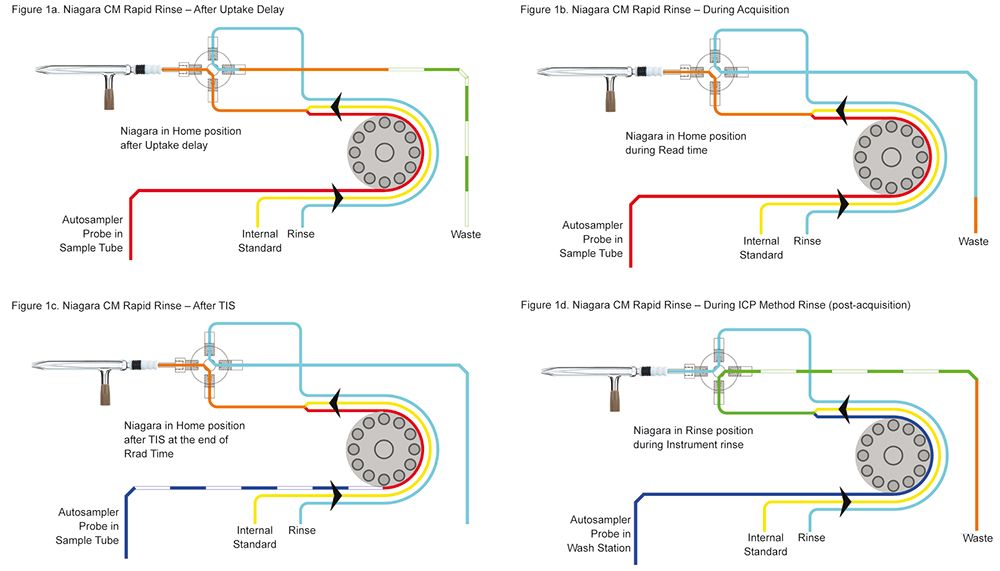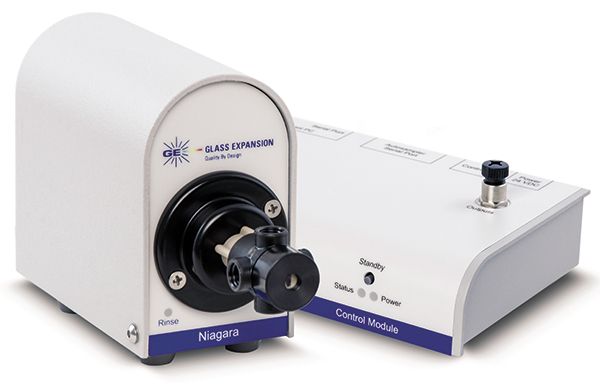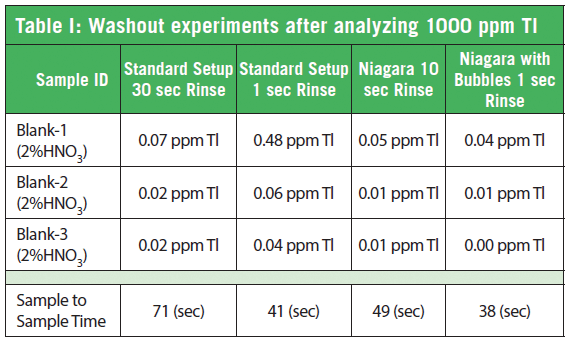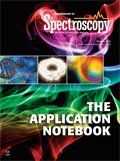A Simple, Low-Cost Approach to Improving ICP Productivity
Application Notebook
Glass Expansion has partnered with Inorganic Ventures, the well-known certified reference material (CRM) manufacturer, to investigate a simple, low cost approach to improving ICP productivity. The benefits of Glass Expansion's redesigned Niagara CM Rapid Rinse accessory were evaluated.
Most ICP systems incorporate an autosampler. With these systems there is a significant delay between the time when the autosampler probe enters the sample and the time when the sample reaches the nebulizer. There is similar delay between the time when the probe enters the rinse and the time when the rinse reaches the nebulizer. If these delays could be eliminated, the analysis time per sample would be reduced.
This is exactly what the Niagara CM Rapid Rinse (referred to as Niagara henceforth) achieves, by rinsing the nebulizer and spray chamber the instant the sample measurement is completed and continuing to rinse until the next sample has reached the nebulizer. Thus the rinse is carried out during the time it takes for the sample and the rinse solutions to flow from the autosampler probe to the nebulizer. Typical time saved with the Niagara is around 30% and since the valve switches immediately after the read is complete, you also minimize the amount of sample introduced to the ICP. This feature drastically reduces consumables costs and frequency of cleaning, particularly for challenging sample matrices.
Niagara Updates
Since the original Niagara was introduced in January 2005 (2), Glass Expansion's line of enhanced productivity accessories have been continuously evolving to keep up with the demands of ICP analyses. Most recently, in 2013 the Control Module (CM) was introduced adding the suffix CM to denote this (3).
We now introduce a new software version, called NRRV2, which includes a redesigned Method Wizard featuring an Uptake Delay Calculator, Rinse Tubing Calculator, and Time in Sample (TIS) Calculator. The addition of these calculators greatly simplifies method development.
The Uptake Delay Time is the time required for the sample to reach the valve and pass through to waste. Once the Uptake Delay Time has finished, the Niagara actuator will switch from Rinse to the Home position, directing the sample to the nebulizer (Figure 1a). The Uptake Delay Time is calculated based on the ID and length of the autosampler probe, peristaltic pump tubing ID and length, and RPM of the peristaltic pump. The Rinse Tubing Calculator calculates the optimum peristaltic pump tubing to be used in order to achieve the same flow rate that is used during analysis while using a fast pump during the uptake and post-acquisition rinsing steps of the analysis, thereby maximizing stability. TIS is the time required for the autosampler probe to remain in the sample tube during the acquisition (Figure 1b). The TIS is based the total read time, RPM of the peristaltic pump and dimensions of the uptake tubing referenced previously.
It is well known that adding a series of bubbles can help "scrub" the uptake line. However, air bubbles introduced into the plasma can lead to instability and require longer stabilization delay times. With this latest Niagara update, we can easily add a series of air bubbles with a post wash command without the worry of introducing any air or extra argon into the plasma (Figure 1c). Once the ICP method rinse begins the air bubbles and any excess sample are directed to waste while rinse solution is directed to the nebulizer (Figure 1d).

Figure 1: a: Niagara CM Rapid Rinse–after uptake delay; b: Niagara CM Rapid Rinse–during acquisition; c: Niagara CM Rapid Rinse–after TIS; d: Niagara CM Rapid Rinse–during ICP method rinse (post-acquisition).
Experimental
The speed and performance of Inorganic Venture's single element CRM ICP-OES certification analysis was compared with and without the use of the Niagara. For these certification experiments a Spectro Arcos EOP (Axial) ICP-OES instrument was used in combination with two Glass Expansion sample introduction systems. For samples without HF, the SeaSpray DC nebulizer was used with the Twister spray chamber. The HF-resistant package consisted of the DuraMist DC nebulizer, Tracey PTFE spray chamber and fully ceramic D-Torch (3).
The Niagara (Figure 2), consists of an electronically controlled switching valve, Control Module and tubing kit. For maximum chemical resistance the valve is made entirely of Teflon and PEEK. The method timings for the Niagara were calculated using the newly developed Method Wizard (4).

Figure 2: Niagara CM Rapid Rinse.
Results
The Niagara allowed Inorganic Ventures to reduce their certification analysis time by 71 s per sample, roughly a 35% improvement. This allows Inorganic Ventures to run an addition 10 samples per hour with the Niagara. The performance of the ICP is unaffected by the Niagara, as an average RSD of less than 0.5% was achieved with both sample introduction systems (4).
In addition to reducing analysis time, the Niagara also improved washout. Thallium (Tl) is known to be a "sticky" element that can necessitate long wash times. For this reason a 1000 ppm Tl solution was chosen to compare washout with and without the Niagara. Table I contains values in ppm Tl for three consecutive 2% HNO3 blank solutions that were run after a 1000 ppm Tl sample. With only a 10 s rinse, the Niagara achieved a better washout compared to a 30 s rinse without the Niagara, saving a considerable amount of time (31%). Adding bubbles reduced carryover even further, giving better than 4 orders of magnitude washout with a 46% savings in time compared to the standard setup.

Table I: Washout experiments after analyzing 1000 ppm Tl
Conclusions
The Niagara CM Rapid Rinse provides a simple, low cost approach to improving ICP productivity. Typical time saved with the Niagara is approximately 30%, with little to no changes to the current ICP method settings and no degradation in performance. The new NRRV2 software with Method Wizard facilitates easy optimization and self-installation. A unique post wash adding a series of bubbles significantly improves washout and reduces rinse time. Also noteworthy, the initial financial investment of the Niagara is 60% to 70% less than other commercially available switching valve systems.
References
(1) Glass Expansion October 2013 Newsletter, "How to Achieve High Accuracy with Difficult Samples."
(2) Glass Expansion October 2005 Newsletter, "Increasing the Productivity of ICP Analyses."
(3) Glass Expansion February 2013 Newsletter, "Latest Developments in Enhanced Productivity Products."
(4) Glass Expansion June 2016 Newsletter, "A Simple, Low Cost Approach to Improving ICP Productivity."

Glass Expansion Inc.
4 Barlows Landing Rd., Unit 2A, Pocasset, MA 02559
tel. (508) 563-1800, fax (508) 563-1802
Website: www.geicp.com
